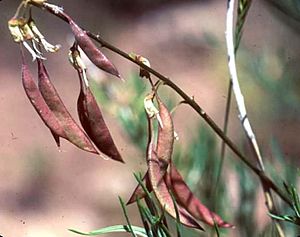Ripley's milkvetch facts for kids
Quick facts for kids Ripley's milkvetch |
|
|---|---|
 |
|
| Conservation status | |
| Scientific classification |
Astragalus ripleyi is a type of flowering plant. It belongs to the legume family, which includes peas and beans. People often call it Ripley's milkvetch. This plant grows naturally in the southern parts of Colorado and the northern parts of New Mexico in the United States.
What it Looks Like
This plant is a perennial herb. This means it lives for more than two years. It can grow up to one meter (about 3 feet) tall. Its stems grow from a thick, woody base called a caudex that is underground. This underground base can also spread like a rhizome, sending out new stems.
The leaves of Ripley's milkvetch are compound. This means each leaf is made up of smaller parts called leaflets. A single leaf can have up to 19 leaflets. The whole plant is quite hairy. These hairs are silvery, which makes the plant look a bit grayish.
The flowers are bright yellow. Each flower is about 1 to 2 centimeters long. After the flowers, the plant produces a flat fruit. This fruit is a pod, similar to a pea pod, and can be up to 3 centimeters long. Each fruit has a long stalk, called a stipe, which connects it to the stem. Ripley's milkvetch usually blooms in June and July.
Where it Lives
Ripley's milkvetch grows in the southern Rocky Mountains. You can find it in different kinds of natural areas. These include ponderosa pine savannas, which are grasslands with scattered trees. It also lives in pinyon-juniper woodlands, shrublands, and open meadows.
This plant is often found growing near shrubs. Some common shrubs it grows next to are sagebrush, Gambel oak, and different types of rabbitbrush and juniper. These shrubs might create a special small area, called a microclimate, where the milkvetch can grow better. Or, the milkvetch might stay hidden under shrubs to avoid being eaten by animals.
The areas where this plant grows usually have many different kinds of plants, showing high biodiversity. Some trees you might see there include white fir, Colorado pinyon, aspen, and Douglas fir. The plant only grows in areas with volcanic soils.
Where it is Found
This plant is only found in a few specific places. In New Mexico, it grows in Taos and Rio Arriba Counties. In Colorado, it is found in Conejos County, Colorado.
Even though it's only in a small area, there can be many plants in one spot. Scientists estimate there are about 10,000 individual Ripley's milkvetch plants in total.
Protecting the Plant
Ripley's milkvetch is a tasty plant for many animals. Because of this, it can be heavily grazed, meaning animals eat a lot of it. Grazing, especially by sheep, is a big problem for its survival. Wild animals also eat the plant.
Another threat comes from invasive plant species. These are plants that are not native to the area and can take over. Some types of clover are a concern. Other dangers include fire suppression, which changes the natural environment. Anything that causes erosion in its habitat, like soil washing away, also threatens the plant.


